- Home
- Blog
- WebFX News
- CTRL + FX: October 2025 Digital Marketing Trends, Tactics, & Tools You Can’t Afford To Miss
CTRL + FX: October 2025 Digital Marketing Trends, Tactics, & Tools You Can’t Afford To Miss
-
 Published: Nov 10, 2025
Published: Nov 10, 2025
-
 10 min. read
10 min. read
-
Summarize in ChatGPT
-
 Albert Dandy Velasquez
Albert Dandy Velasquez Content Specialist
Content Specialist
- Albert Dandy Velasquez blends SEO strategy with compelling storytelling to help businesses boost their visibility and revenue online. With a B.A. in English and certifications from HubSpot, Semrush, and Google Analytics, he has written and optimized hundreds of articles on organic SEO, content strategy, and user experience. He regularly contributes to the WebFX blog and SEO.com, creating content that helps readers turn marketing goals into measurable results. When he’s off the clock, he’s usually exploring new neighborhoods on two wheels, filming travel content, or chasing golden hour with a coffee in hand.
- What is agentic commerce and why does it matter? Agentic commerce is AI that completes purchases on behalf of users, collapsing the entire buying journey from question to checkout into a single interaction without requiring users to visit external websites or navigate multiple tabs.
- How are AI platforms disrupting traditional e-commerce? Generative AI platforms like ChatGPT, Perplexity, and Google Gemini are adding direct commerce capabilities that allow users to complete purchases within 60 seconds without leaving the AI interface, bypassing traditional retailer websites entirely.
- What is revenue marketing and how does it differ from traditional marketing? Revenue marketing uses actual closed deals (not just leads or traffic) to inform every tactical decision, from keyword bidding to content creation, shifting focus from vanity metrics like cost per lead to revenue per marketing dollar.
- Why is structured data critical for AI citations? Structured data (schema markup) makes content machine-readable so AI engines like ChatGPT, Gemini, and Perplexity can parse and cite your brand within answers, transforming pages from merely rankable to AI-citable and increasing visibility in AI-generated responses.
- How should marketers adapt to AI-driven shopping? Marketers must deploy product schema markup, simplify checkout flows, optimize for conversational queries, join merchant programs like Perplexity’s, and test their AI discoverability across platforms to remain competitive as AI collapses traditional sales funnels.
October hit different this year.
Not because the leaves changed or pumpkin spice returned. October hit different because somewhere between your morning coffee and your 3 p.m. slump, artificial intelligence (AI) stopped being your research assistant and became your customer’s personal shopper. And unlike you, it doesn’t take lunch breaks.
Q4 is a reckoning. And right now, every marketer is split into two camps: Those who adapted when AI learned to transact and those still wondering why their traffic stopped converting.
This month’s CTRL + FX is your survival kit. Because the rules changed while you weren’t looking, and “I didn’t know” isn’t going to fly in January when they ask why you missed your number.
Why don’t we break down the digital marketing trends, tactics, and tools actually moving the needle while everyone else is still talking about it:
- Trend watch: When AI stops suggesting and starts shopping
- Tactic talk: Your revenue data isn’t the scoreboard. It’s the strategy.
- Team POV: Make your pages AI-citable (not just rankable)
Let’s get to work.
40 Free Marketing Tools to Grow Your Online Presence
At WebFX, we’ve created our own toolbox that helps our clients increase the success of their business from online marketing channels. Explore our toolbox below!
Browse our Free Tools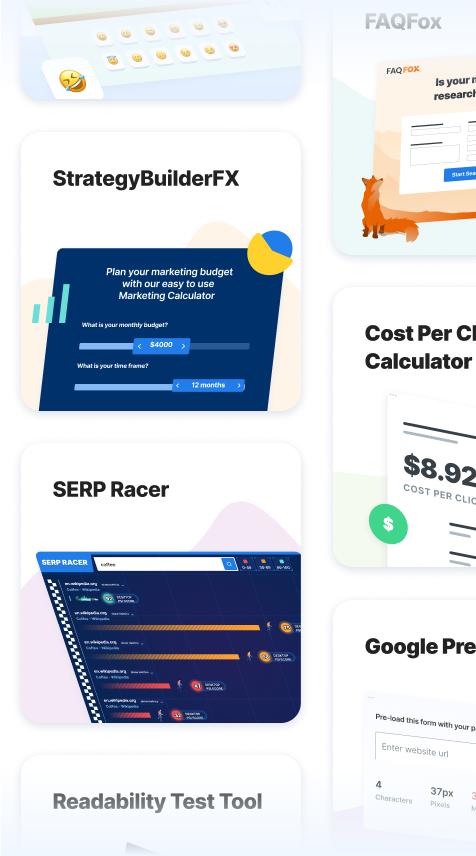

Trend watch: When AI stops suggesting and starts shopping
Think AI shopping assistants are just glorified chatbots? Think again.
In the past 12 months, AI didn’t just get smarter. It got transactional. We’re not talking about product recommendations or comparison tables anymore. We’re talking about platforms that let users go from “I need running shoes” to checkout confirmation without ever leaving the conversation. No tabs. No external sites. No friction.
This is agentic commerce: AI that acts on your behalf, completes purchases, and collapses the entire buying journey into a single interaction.
And the shift is happening from two directions at once.
1. AI engines that shop: Generative platforms adding commerce
The giant generative AI platforms aren’t content being merely research tools. They want to close the loop, and most importantly, the sale.
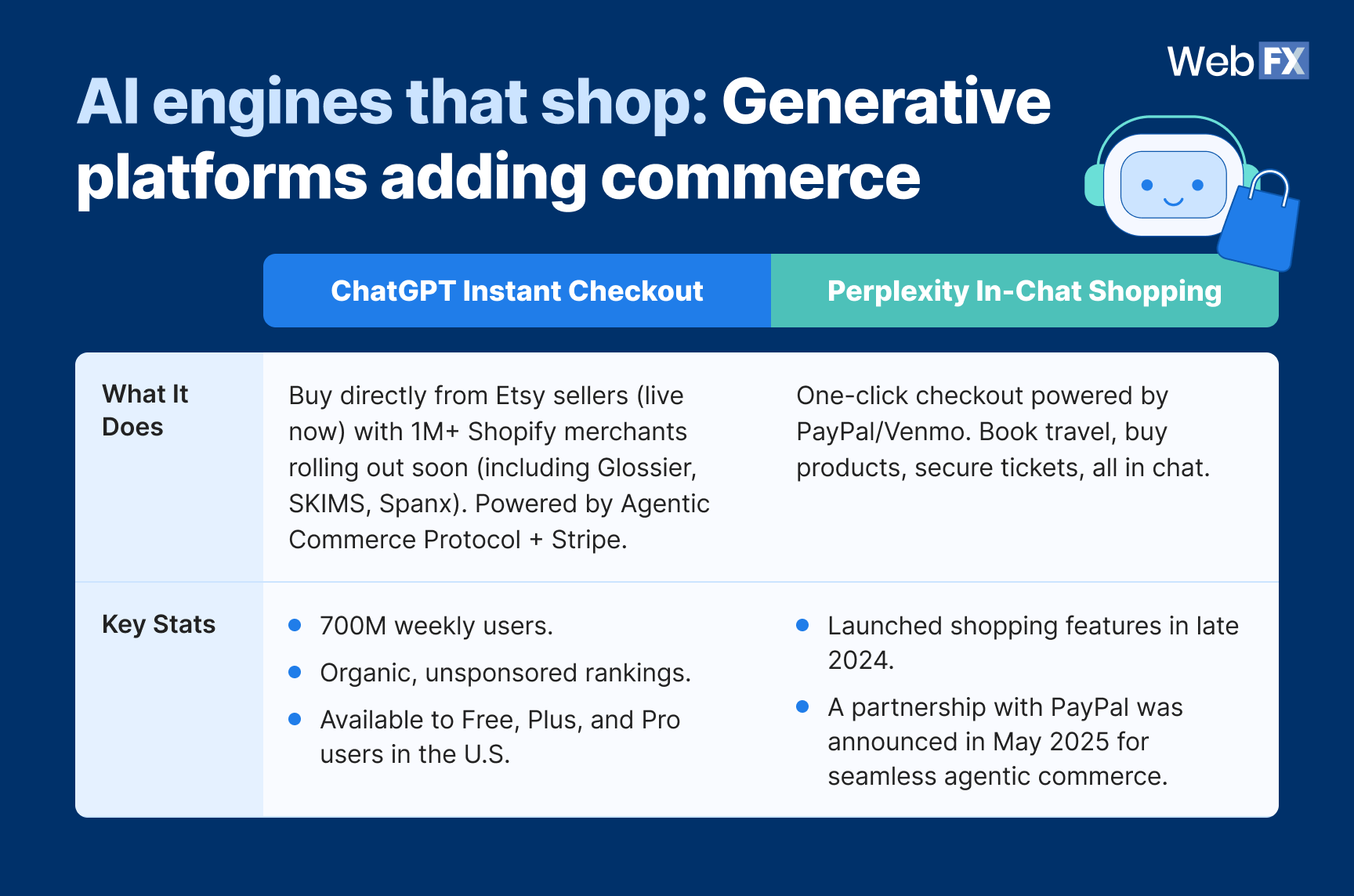
Source Data
| Platform | What It Does | Key Stats |
| ChatGPT Instant Checkout | Buy directly from Etsy sellers (live now) with 1M+ Shopify merchants rolling out soon (including Glossier, SKIMS, Spanx). Powered by Agentic Commerce Protocol + Stripe. |
|
| Perplexity In-Chat Shopping | One-click checkout powered by PayPal/Venmo. Book travel, buy products, secure tickets, all in chat. |
|
ChatGPT Instant Checkout
In September 2025, OpenAI launched ChatGPT Instant Checkout, turning its 700 million weekly users into potential customers for any merchant who integrates. Powered by the Agentic Commerce Protocol (built with Stripe), U.S. users (across Free, Plus, and Pro tiers) can now buy directly from Etsy sellers without leaving the chat.
Over 1 million Shopify merchants, including brands like Glossier, SKIMS, Spanx, and Vuori, are rolling out soon. Ask for “gifts for a ceramics lover,” tap “Buy,” confirm your details, and you’re done. The kicker? Product rankings are organic and unsponsored. It’s relevance-first commerce, and it’s live right now.
Perplexity In-Chat Shopping
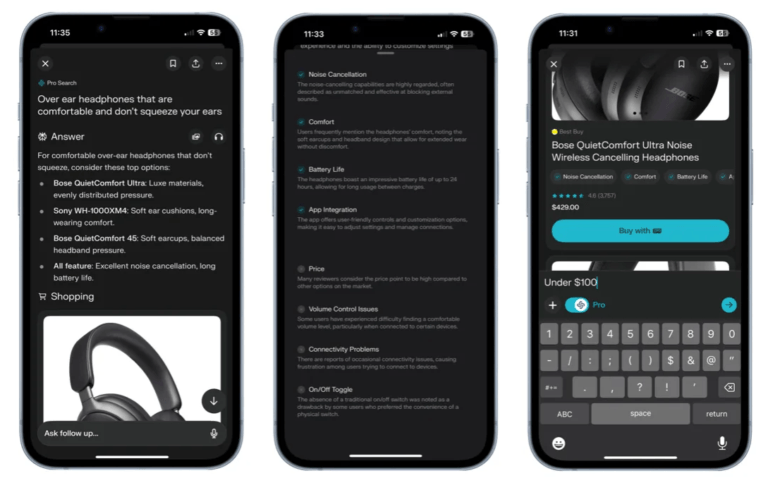
Perplexity has been building its agentic commerce experience throughout 2024 and 2025, culminating in a May 2025 partnership with PayPal that enables true one-click checkout. With Perplexity in-chat shopping, users can now book travel, buy products, and secure concert tickets directly in chat, paying instantly with PayPal or Venmo.
PayPal handles processing, shipping, tracking, and support, making the entire transaction seamless. Perplexity’s bet? That conversational commerce beats traditional browsing. And early signals suggest they’re right: Users are moving from research to purchase without ever opening a new tab.
What makes them disruptive:
- Zero friction: From question to purchase in under 60 seconds
- No site visits required: Users never leave the AI interface
- Relevance-first rankings: Product recommendations based on fit, not ad spend
2. Retailers adding AI agents: Commerce platforms adding AI
Meanwhile, the retail giants saw the threat and built their own defenses: AI assistants designed to keep shoppers inside their ecosystems.
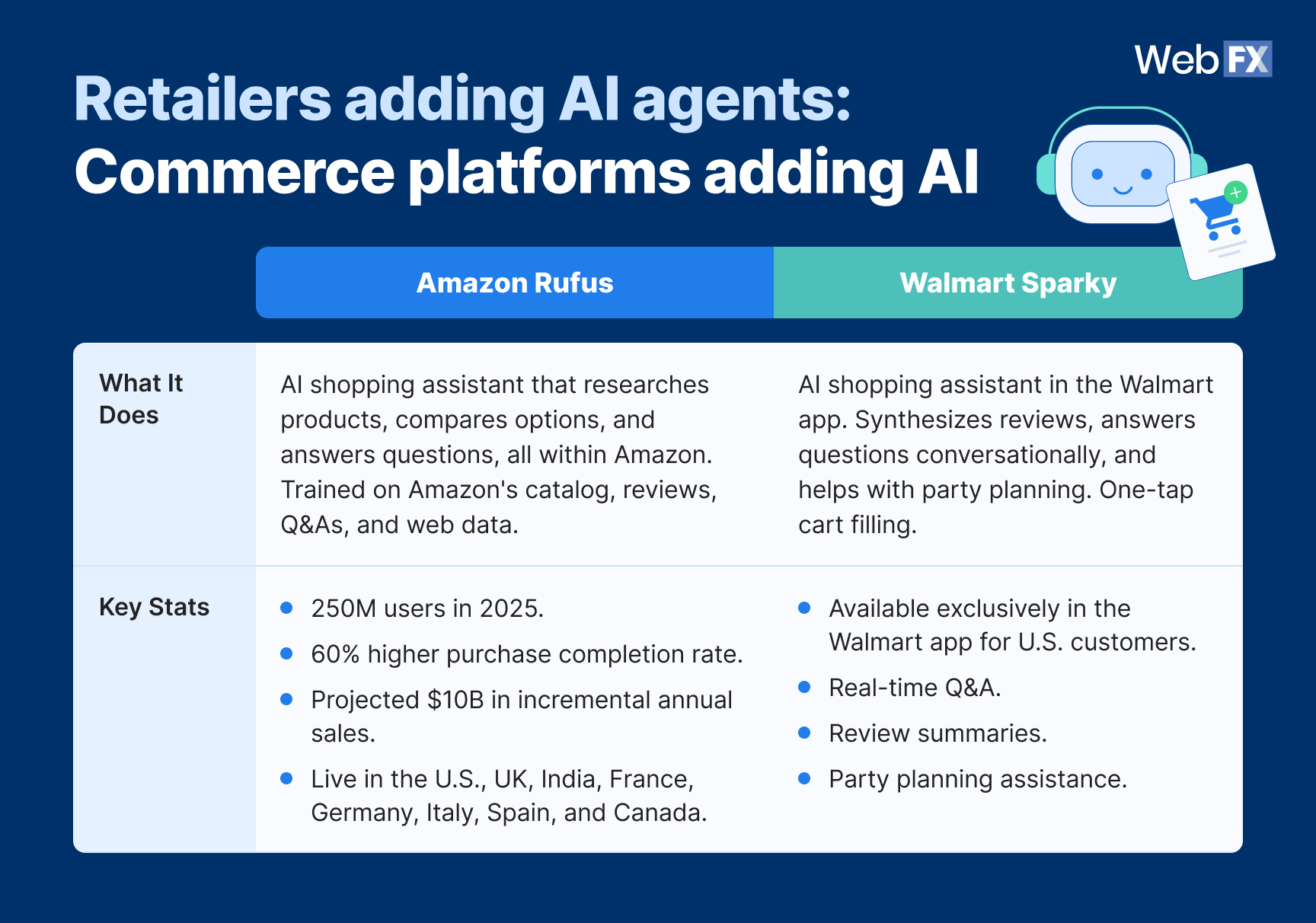
Source Data
| Platform | What It Does | Key Stats |
| Amazon Rufus | AI shopping assistant that researches products, compares options, and answers questions, all within Amazon. Trained on Amazon’s catalog, reviews, Q&As, and web data. |
|
| Walmart Sparky | AI shopping assistant in the Walmart app. Synthesizes reviews, answers questions conversationally, and helps with party planning. One-tap cart filling. |
|
Amazon Rufus

Amazon Rufus rolled out across the U.S., UK, India, and Europe throughout 2025. The AI assistant is embedded directly in Amazon’s mobile app and website, trained on Amazon’s entire product catalog, customer reviews, community Q&As, and information from across the web.
Shoppers can ask anything from broad comparisons (“what’s the difference between trail and road running shoes?”) to specific questions (“is this jacket machine washable?”). The results speak for themselves: 250 million shoppers used Rufus in 2025, and customers who engage with it are 60% more likely to complete a purchase. Amazon projects Rufus will drive over $10 billion in incremental annual sales, making it one of the company’s most successful consumer-facing AI bets.
Walmart Sparky

Walmart’s answer is Sparky, an AI shopping assistant available exclusively in the Walmart app for U.S. customers. Sparky helps shoppers find products, synthesizes review summaries, and answers questions conversationally like “what’s the best laptop for an art student?” and “help me plan a birthday party for a 2-year-old.”
The assistant can even suggest party supplies, provide themed inspiration, and fill your cart in one tap. Sparky’s party planning feature is particularly notable, allowing users to get curated recommendations for birthdays, housewarmings, and other events. It’s Walmart’s play to keep customers shopping in-app rather than losing them to Google, ChatGPT, or Perplexity.
Why retailers had to respond:
- Threat of disintermediation: AI platforms could bypass Amazon/Walmart entirely, stealing discovery and transactions
- Customer retention: Keep shoppers in their ecosystem, not someone else’s interface
- Data control: Own the shopping behavior data and insights, rather than sharing with OpenAI or Perplexity
How to adapt before agentic commerce leaves you behind
Marketing used to work like this:
Awareness → Consideration → Decision → PurchaseAgentic commerce works like this:
Question → Answer → Purchase
Three steps became one. And if your product isn’t machine-readable, if your checkout flow has friction, if your content answers keywords instead of questions, then you just got deleted from the new equation.
So the question isn’t “should we optimize for agentic commerce?” The question is: “Can we afford not to when our competitors already are?” The window is still open, but it’s closing fast.
Here’s your action plan:
- Deploy product schema markup: Use structured data (Product, Offer, Review schema) so AI engines can parse your listings. Schema makes your content machine-readable and increases your chances of being cited.
- Simplify checkout flows: Reduce form fields. Enable guest checkout. Support digital wallets (Apple Pay, Google Pay, Stripe, PayPal). Every extra step is a conversion killer when AI is trying to complete the purchase.
- Optimize for conversational queries: Answer how people actually talk to AI, like “What are the best running shoes for marathon training?” not “men’s running shoes size 10.” Write FAQs that mirror real questions. Use natural language.
- Join merchant programs: If you’re on Shopify or use Stripe, you’re already halfway there. Apply for Perplexity’s merchant program and ChatGPT Instant Checkout integration. Get on their radar before your competitors do.
- Test your AI discoverability: Search for your products in ChatGPT, Perplexity, Amazon Rufus, and Walmart Sparky. Are you showing up? Are your competitors? If not, diagnose why and fix it immediately.
Tactic talk: Your revenue data isn’t the scoreboard. It’s the strategy.
Most marketers pull revenue reports once a month, nod at the numbers, and file them away. Maybe they share them in a Slack channel. Maybe they present them in a deck. And then? Nothing changes.
The problem here is that revenue data isn’t a performance review. Unbeknownst to many, it’s actually a strategic weapon.
The marketers who win in Q4 (and beyond) aren’t the ones with the prettiest dashboards. They’re the ones who take sales data and reverse-engineer it into every decision they make. And ultimately, answer questions like what to bid on, what content to create, which pages to optimize, and where to cut budget that’s bleeding ROI.
This is revenue marketing: Using actual closed deals (not just leads, not just traffic) to inform every tactical move you make. And if you’re not doing it yet? Your competitors are.
🎥 Video: What is revenue marketing? Explained by an actual revenue marketer
How revenue data transforms your organic strategy
By now, we’re sure most marketers (if not all) already know that search engine optimization (SEO) isn’t about ranking for keywords anymore. It’s about ranking for the right keywords, the ones that actually close deals.
Revenue data tells you exactly which products, services, and content drive sales. Once you know that, you can double down on what works and stop wasting effort on content that ranks but doesn’t convert.
The shift: From “what ranks” to “what converts and closes.”
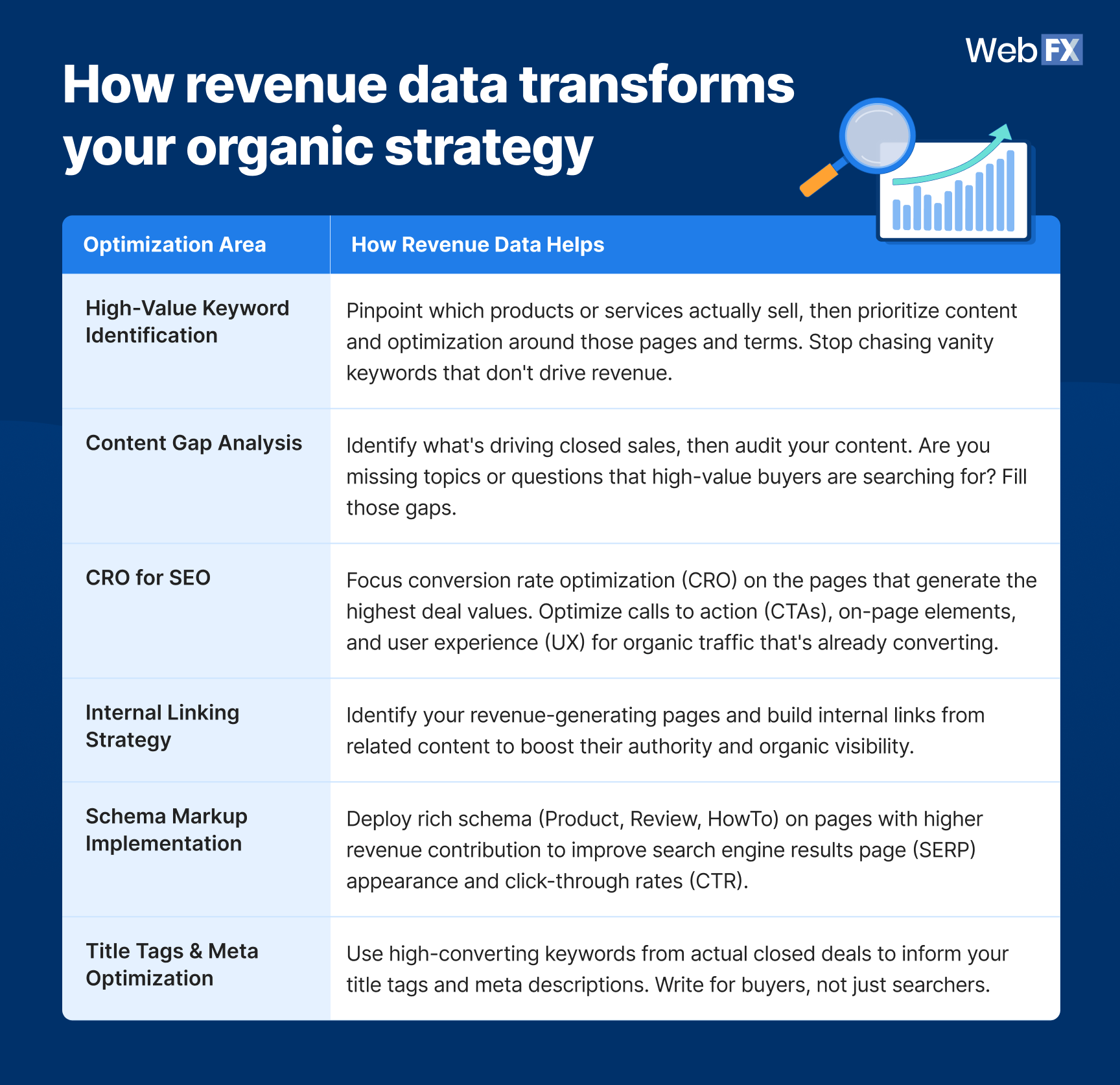
Source Data
| Optimization Area | How Revenue Data Helps |
| High-Value Keyword Identification | Pinpoint which products or services actually sell, then prioritize content and optimization around those pages and terms. Stop chasing vanity keywords that don’t drive revenue. |
| Content Gap Analysis | Identify what’s driving closed sales, then audit your content. Are you missing topics or questions that high-value buyers are searching for? Fill those gaps. |
| CRO for SEO | Focus conversion rate optimization (CRO) on the pages that generate the highest deal values. Optimize calls to action (CTAs), on-page elements, and user experience (UX) for organic traffic that’s already converting. |
| Internal Linking Strategy | Identify your revenue-generating pages and build internal links from related content to boost their authority and organic visibility. |
| Schema Markup Implementation | Deploy rich schema (Product, Review, HowTo) on pages with higher revenue contribution to improve search engine results page (SERP) appearance and click-through rates (CTR). |
| Title Tags & Meta Optimization | Use high-converting keywords from actual closed deals to inform your title tags and meta descriptions. Write for buyers, not just searchers. |
How revenue data transforms your paid strategy
Paid campaigns without revenue data are just expensive traffic experiments.
When you know which keywords, ad copy, and landing pages actually drive closed deals (not just form fills), you can allocate budget with precision. No more guessing. No more “let’s test this and see what happens.” Just data-driven decisions that compound ROI.
The shift: From “cost per lead” to “revenue per marketing dollar.”

Source Data
| Optimization Area | How Revenue Data Helps |
| High-Value Keyword Bidding | Adjust bids to prioritize keywords that drive the most revenue, not just the most conversions. A $5 CPA is meaningless if those leads never close. |
| Ad Copy Optimization | Highlight the products or services that generate the most revenue in your ad copy. Speak directly to what actually sells. |
| Landing Page Optimization | Identify which landing pages contribute most to closed deals. Focus your CRO efforts there: Improve content, CTAs, and UX to boost conversion rates and quality scores. |
| Audience Targeting Refinement | Segment audiences by revenue potential or deal stage. Target high-value prospects with tailored messaging instead of one-size-fits-all campaigns. |
| Budget Allocation | Analyze revenue attribution across campaigns and channels. Shift the budget away from volume plays and toward what actually closes deals. |
How revenue data informs your content strategy
Much like SEO and PPC, content marketing without revenue data is purely guesswork.
You’re creating blog posts, guides, and resources based on what you think resonates. Revenue data shows you what actually resonates, and more importantly, what drives buyers to take action.
The shift: From “content for traffic” to “content for revenue.”
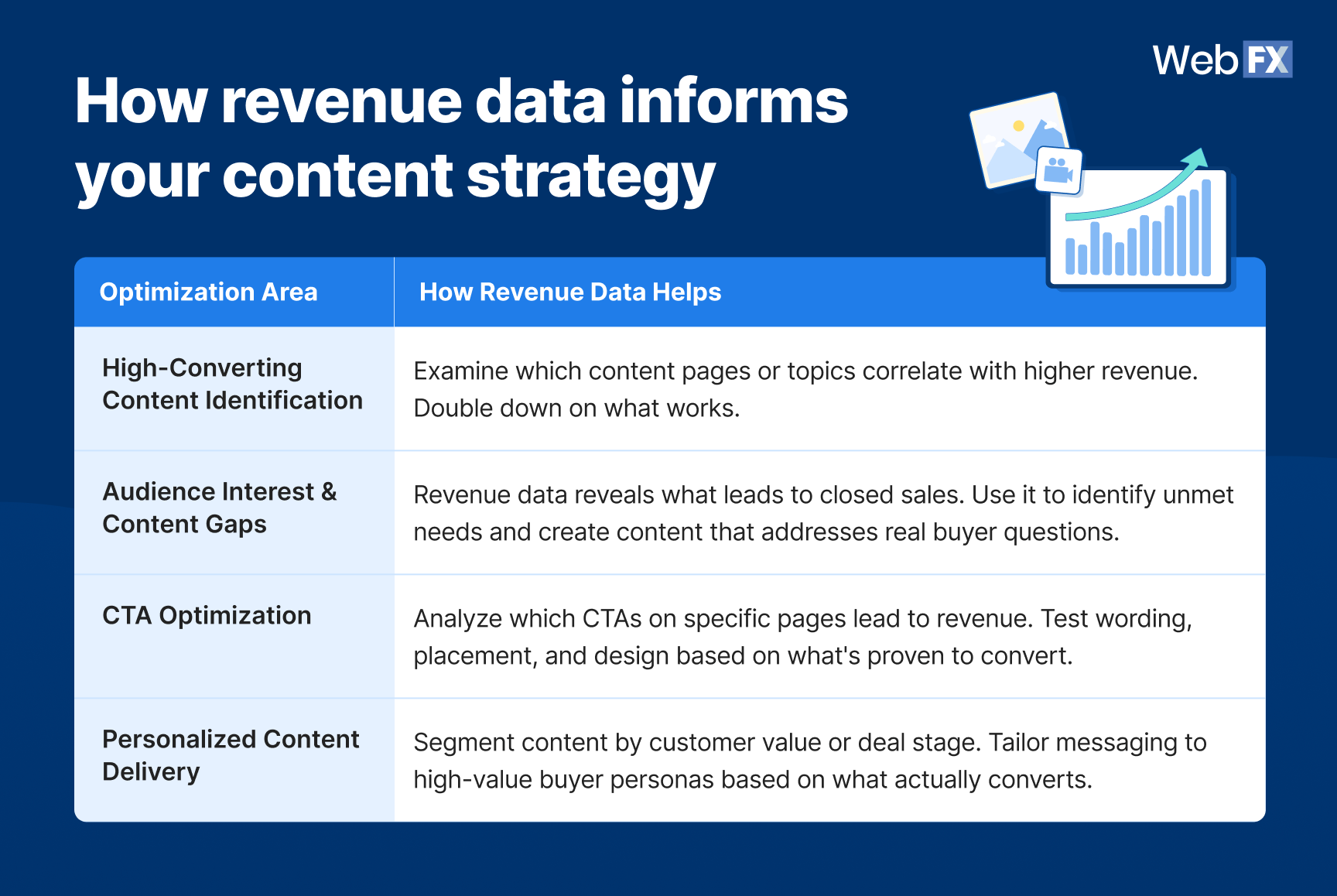
Source Data
| Optimization Area | How Revenue Data Helps |
| High-Converting Content Identification | Examine which content pages or topics correlate with higher revenue. Double down on what works. |
| Audience Interest & Content Gaps | Revenue data reveals what leads to closed sales. Use it to identify unmet needs and create content that addresses real buyer questions. |
| CTA Optimization | Analyze which CTAs on specific pages lead to revenue. Test wording, placement, and design based on what’s proven to convert. |
| Personalized Content Delivery | Segment content by customer value or deal stage. Tailor messaging to high-value buyer personas based on what actually converts. |
The revenue marketing mindset
In the grand scheme of things, revenue marketing isn’t about bigger dashboards or fancier reports. It’s about making smarter decisions, faster. And if you want to get started on this, here is a simple checklist to follow:
- Audit your top revenue-generating pages. What’s working? What’s common across them? Do more of that.
- Map keywords to closed deals, not just leads. Optimize and bid based on revenue potential, not search volume.
- Identify your highest-value content. What pages assist in the most closed deals? Promote them. Improve them. Link to them.
- Allocate budget by revenue per marketing dollar. Stop measuring success by leads. Measure it by deals closed.
- Build content around what sells. Create more content related to your highest-revenue products or services.
- Connect deals to marketing efforts. Use attribution tools like RevenueCloudFX to track which campaigns, keywords, and content actually close deals (not just generate leads).
The choice is simple: Keep optimizing for vanity metrics, or start optimizing for what actually pays the bills. Revenue marketing isn’t optional in 2025. It’s table stakes.
Team POV: Make your pages AI-citable (not just rankable)
If LLMs can’t parse it, they won’t cite it. Structured data is how you speak machine, so ChatGPT, Gemini, and Perplexity can pull (and credit) your brand inside answers.
Our stance: Treat schema markup as distribution infrastructure, not a nice-to-have. It’s how you move beyond “appearing in results” to being the result.
Side note: Structured data doesn’t guarantee AI citations, but it raises your odds by making entities, authorship, dates, and facts machine-readable.
The FX “cite-ready” pattern (at a glance)
Want AI to cite you? Build pages like this: Short, scannable, structured, and credible.
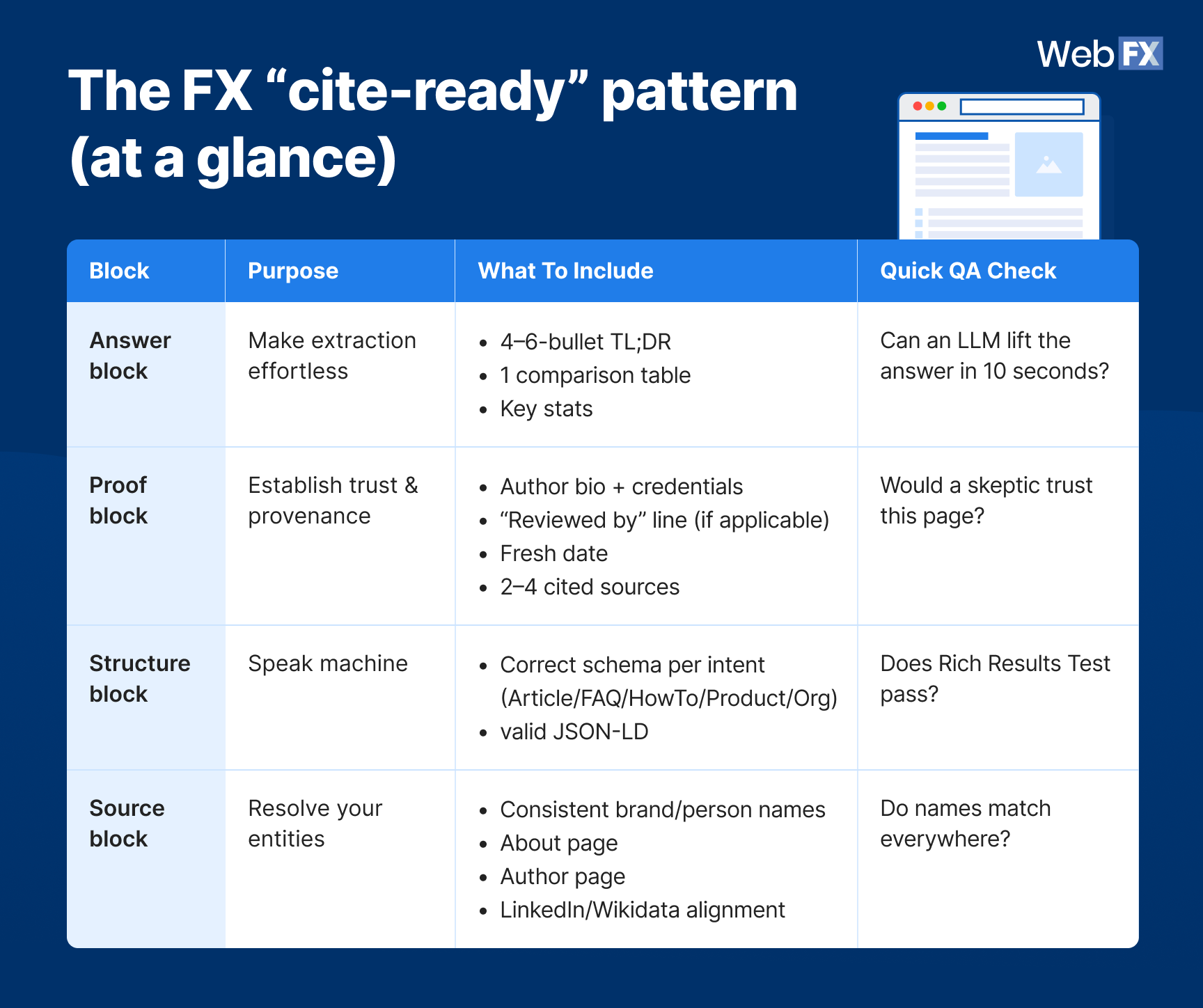
Source Data
| Block | Purpose | What To Include | Quick QA Check |
| Answer block | Make extraction effortless |
|
Can an LLM lift the answer in 10 seconds? |
| Proof block | Establish trust & provenance |
|
Would a skeptic trust this page? |
| Structure block | Speak machine |
|
Does Rich Results Test pass? |
| Source block | Resolve your entities |
|
Do names match everywhere? |
Which schema, when (match intent to markup)
Schema only works when it fits the content. Use this quick guide to choose the right type fast.
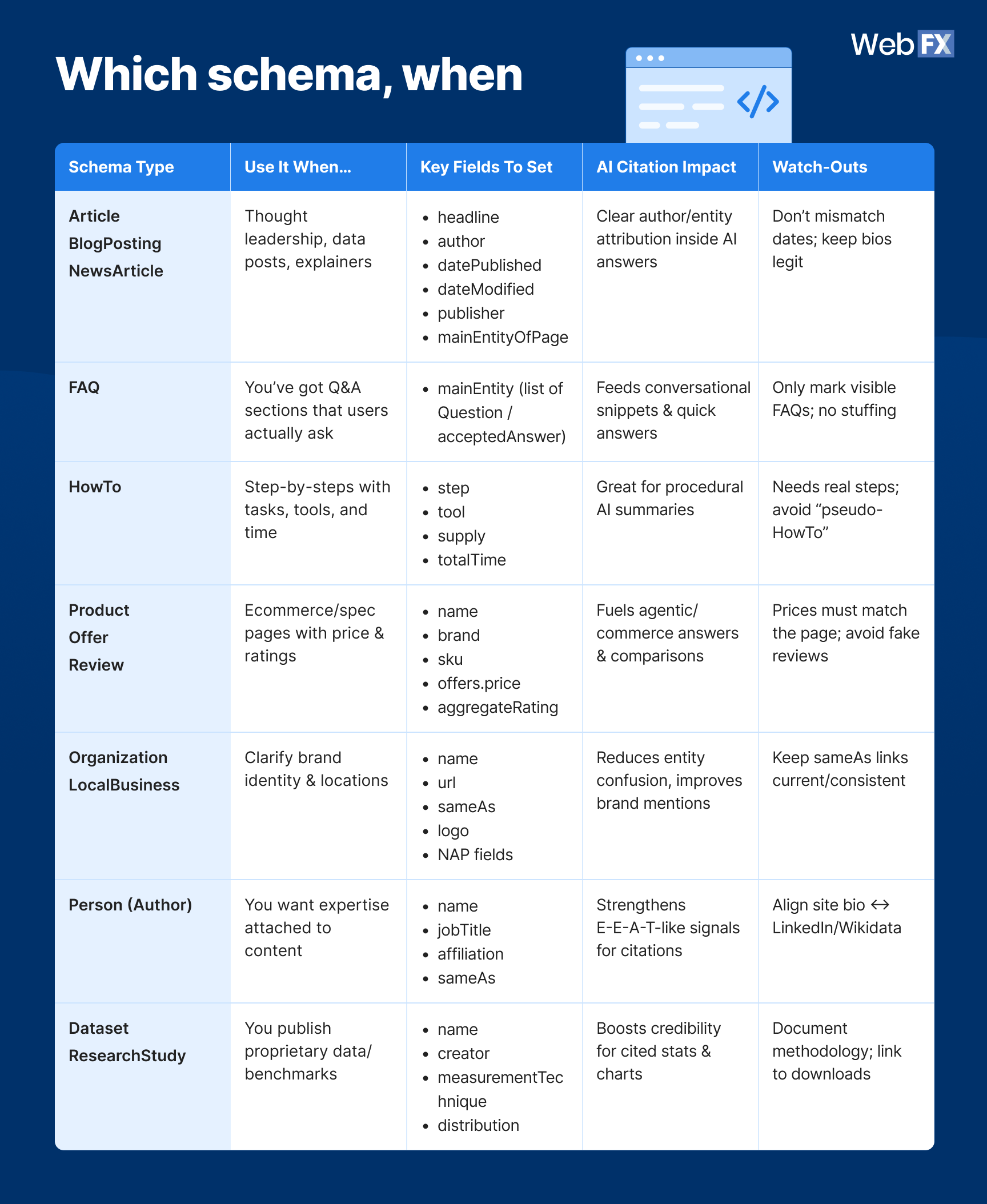
Source Data
| Schema Type | Use It When… | Key Fields To Set | AI Citation Impact | Watch-Outs |
| Article
BlogPosting NewsArticle |
Thought leadership, data posts, explainers |
|
Clear author/entity attribution inside AI answers | Don’t mismatch dates; keep bios legit |
| FAQ | You’ve got Q&A sections that users actually ask |
|
Feeds conversational snippets & quick answers | Only mark visible FAQs; no stuffing |
| HowTo | Step-by-steps with tasks, tools, and time |
|
Great for procedural AI summaries | Needs real steps; avoid “pseudo-HowTo” |
| Product
Offer Review |
Ecommerce/spec pages with price & ratings |
|
Fuels agentic/commerce answers & comparisons | Prices must match the page; avoid fake reviews |
| Organization
LocalBusiness |
Clarify brand identity & locations |
|
Reduces entity confusion, improves brand mentions | Keep sameAs links current/consistent |
| Person (Author) | You want expertise attached to content |
|
Strengthens E-E-A-T-like signals for citations | Align site bio ↔ LinkedIn/Wikidata |
| Dataset
ResearchStudy |
You publish proprietary data/benchmarks |
|
Boosts credibility for cited stats & charts | Document methodology; link to downloads |
The difference between being ranked and being cited is not creativity. It is structure. AI doesn’t care how clever your prose is. It cares if your facts are extractable, your sources are credible, and your entities are clear.
Start here: Pick your 5 highest-traffic pages and run them through Google’s Rich Results Test. If they fail, fix the schema. If they pass, add an answer block at the top. Make it easy for AI to quote you, or watch your competitors get cited instead.
FAQs about our October 2025 drop
What are the biggest digital marketing trends in Q4 2025?
Two digital marketing trends are dominating: Agentic commerce and revenue marketing.
AI platforms like ChatGPT and Perplexity aren’t just recommending products anymore. They’re completing purchases in chat. No tabs, no external sites, just question → answer → checkout. Meanwhile, retailers like Amazon (Rufus) and Walmart (Sparky) built their own AI assistants to keep customers inside their ecosystems.
On the strategy side, smart marketers stopped measuring leads and started measuring revenue. They’re using CRM data to see which campaigns actually close deals, then doubling down on what works. If you’re still optimizing for traffic instead of transactions, you’re already behind.
What is agentic commerce, and how does it affect my business?
Agentic commerce = AI that buys for you.
Ask ChatGPT for “gifts under $50,” tap “Buy,” confirm details, done. No browsing. No cart abandonment. No second-guessing. The entire funnel collapsed into 60 seconds.
Why you should care: If your product pages aren’t machine-readable or your checkout has friction, AI won’t recommend you. It’ll pick the competitor with cleaner data and smoother infrastructure. Amazon’s Rufus alone is projected to drive $10 billion in incremental sales. This isn’t theoretical anymore.
How do I optimize for AI shopping assistants like ChatGPT and Perplexity?
Make it easy for AI to recommend and transact your products. Five moves, right now:
- Deploy product schema: Use Product, Offer, and Review markup so AI can parse your listings
- Obliterate checkout friction: Reduce form fields, enable guest checkout, support Apple Pay/Google Pay/Stripe
- Write like humans talk: Optimize for “best running shoes for marathon training,” not “men’s running shoes size 10”
- Join merchant programs: If you’re on Shopify or use Stripe, apply for ChatGPT Instant Checkout and Perplexity’s merchant program
- Test your visibility: Search your products in ChatGPT, Perplexity, Rufus, and Sparky
What digital marketing tactics actually work in 2025?
Revenue marketing. Full stop. Refrain from optimizing for cost per lead. Start optimizing for revenue per marketing dollar. That means:
- Bidding on keywords that close deals, not keywords with the most volume
- Creating content around your highest-revenue products, not highest-traffic topics
- Allocating budget to channels that drive closed deals, not just conversions
How do I get AI platforms like ChatGPT to cite my content?
Structure beats creativity every time. Here’s a cite-ready formula:
- Answer block: Put a 4-6 bullet TL;DR at the top with key stats LLMs can lift instantly
- Proof block: Author bio with credentials, fresh date, 2-4 legit sources
- Schema markup: Deploy Article, FAQ, or HowTo schema (whatever fits your content)
- Entity consistency: Keep your brand/author names identical across your site, LinkedIn, and Wikidata
Quick test: Run your top 5 pages through Google’s Rich Results Test. If they fail, fix the schema. If they pass, add that answer block at the top. AI doesn’t care how clever your writing is. It cares if your facts are extractable, your sources are credible, and your entities are clear.
WebFX has a track record of success in driving measurable results for businesses like yours.
See how we do it

$10 billion
Revenue Driven For Clients

200+
Industries of Expertise

93%
Client Satisfaction Rating

9:1
Dedicated FXers Per Client
CTRL + close the gap
That’s October 2025 wrapped. Don’t let it sit in a tab graveyard. AI is collapsing funnels, citations are shaping discovery, and revenue data is calling the shots.
November’s CTRL + FX is already in the lab with tighter tests, cleaner datasets, and tools we won’t gatekeep. Got a tactic that punched above its weight or a tool you swear by? Send it our way. We might just feature your play.
Stay sharp between issues. Follow WebFX on Instagram, LinkedIn, and YouTube for raw takes, not reruns. Ready to turn these moves into pipeline and profit? Explore our high-impact revenue marketing services and AI SEO services to see how we execute this playbook every day.
Same shortcut next month. Make Q4 count.
-
 Albert Dandy Velasquez blends SEO strategy with compelling storytelling to help businesses boost their visibility and revenue online. With a B.A. in English and certifications from HubSpot, Semrush, and Google Analytics, he has written and optimized hundreds of articles on organic SEO, content strategy, and user experience. He regularly contributes to the WebFX blog and SEO.com, creating content that helps readers turn marketing goals into measurable results. When he’s off the clock, he’s usually exploring new neighborhoods on two wheels, filming travel content, or chasing golden hour with a coffee in hand.
Albert Dandy Velasquez blends SEO strategy with compelling storytelling to help businesses boost their visibility and revenue online. With a B.A. in English and certifications from HubSpot, Semrush, and Google Analytics, he has written and optimized hundreds of articles on organic SEO, content strategy, and user experience. He regularly contributes to the WebFX blog and SEO.com, creating content that helps readers turn marketing goals into measurable results. When he’s off the clock, he’s usually exploring new neighborhoods on two wheels, filming travel content, or chasing golden hour with a coffee in hand. -

WebFX is a full-service marketing agency with 1,100+ client reviews and a 4.9-star rating on Clutch! Find out how our expert team and revenue-accelerating tech can drive results for you! Learn more
Join our mission
to provide industry-leading digital marketing services to businesses around the globe – all while growing as an individual and leaving the world a better place.
I Want to Apply!

Looking for More?
Get expert ideas, industry updates, case studies, and more straight to your inbox to help you level up and get ahead.
"*" indicates required fields

Proven Marketing Strategies
Join our mission
to provide industry-leading digital marketing services to businesses around the globe – all while growing as an individual and leaving the world a better place.
I Want to Apply!
What to read next




